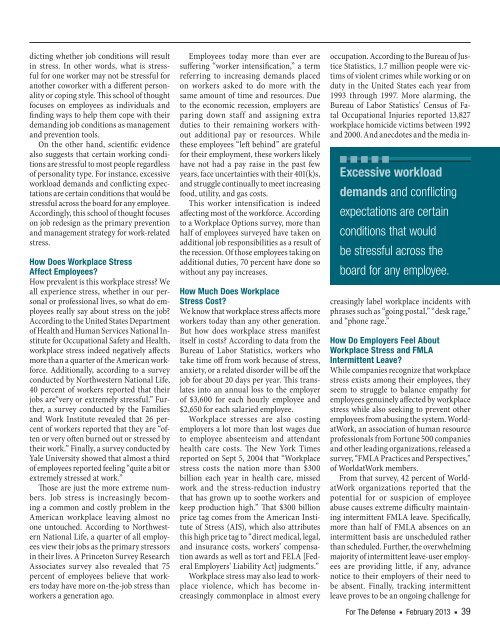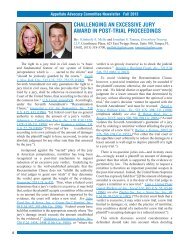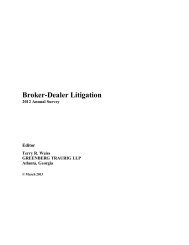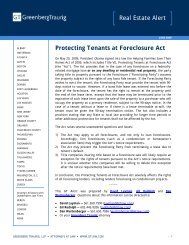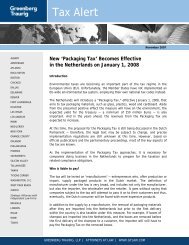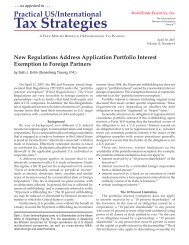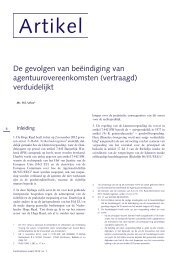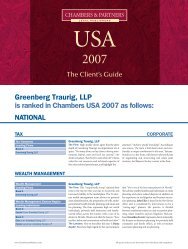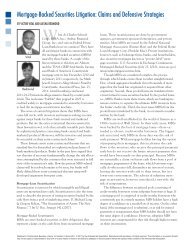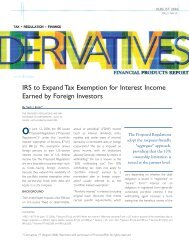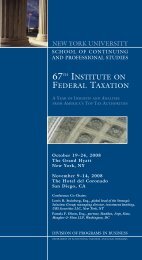Stress Leave Under the FMLA - Greenberg Traurig LLP
Stress Leave Under the FMLA - Greenberg Traurig LLP
Stress Leave Under the FMLA - Greenberg Traurig LLP
Create successful ePaper yourself
Turn your PDF publications into a flip-book with our unique Google optimized e-Paper software.
dicting whe<strong>the</strong>r job conditions will result<br />
in stress. In o<strong>the</strong>r words, what is stressful<br />
for one worker may not be stressful for<br />
ano<strong>the</strong>r coworker with a different personality<br />
or coping style. This school of thought<br />
focuses on employees as individuals and<br />
finding ways to help <strong>the</strong>m cope with <strong>the</strong>ir<br />
demanding job conditions as management<br />
and prevention tools.<br />
On <strong>the</strong> o<strong>the</strong>r hand, scientific evidence<br />
also suggests that certain working conditions<br />
are stressful to most people regardless<br />
of personality type. For instance, excessive<br />
workload demands and conflicting expectations<br />
are certain conditions that would be<br />
stressful across <strong>the</strong> board for any employee.<br />
Accordingly, this school of thought focuses<br />
on job redesign as <strong>the</strong> primary prevention<br />
and management strategy for work- related<br />
stress.<br />
How Does Workplace <strong>Stress</strong><br />
Affect Employees?<br />
How prevalent is this workplace stress? We<br />
all experience stress, whe<strong>the</strong>r in our personal<br />
or professional lives, so what do employees<br />
really say about stress on <strong>the</strong> job?<br />
According to <strong>the</strong> United States Department<br />
of Health and Human Services National Institute<br />
for Occupational Safety and Health,<br />
workplace stress indeed negatively affects<br />
more than a quarter of <strong>the</strong> American workforce.<br />
Additionally, according to a survey<br />
conducted by Northwestern National Life,<br />
40 percent of workers reported that <strong>the</strong>ir<br />
jobs are“very or extremely stressful.” Fur<strong>the</strong>r,<br />
a survey conducted by <strong>the</strong> Families<br />
and Work Institute revealed that 26 percent<br />
of workers reported that <strong>the</strong>y are “often<br />
or very often burned out or stressed by<br />
<strong>the</strong>ir work.” Finally, a survey conducted by<br />
Yale University showed that almost a third<br />
of employees reported feeling “quite a bit or<br />
extremely stressed at work.”<br />
Those are just <strong>the</strong> more extreme numbers.<br />
Job stress is increasingly becoming<br />
a common and costly problem in <strong>the</strong><br />
American workplace leaving almost no<br />
one untouched. According to Northwestern<br />
National Life, a quarter of all employees<br />
view <strong>the</strong>ir jobs as <strong>the</strong> primary stressors<br />
in <strong>the</strong>ir lives. A Princeton Survey Research<br />
Associates survey also revealed that 75<br />
percent of employees believe that workers<br />
today have more on-<strong>the</strong>-job stress than<br />
workers a generation ago.<br />
Employees today more than ever are<br />
suffering “worker intensification,” a term<br />
referring to increasing demands placed<br />
on workers asked to do more with <strong>the</strong><br />
same amount of time and resources. Due<br />
to <strong>the</strong> economic recession, employers are<br />
paring down staff and assigning extra<br />
duties to <strong>the</strong>ir remaining workers without<br />
additional pay or resources. While<br />
<strong>the</strong>se employees “left behind” are grateful<br />
for <strong>the</strong>ir employment, <strong>the</strong>se workers likely<br />
have not had a pay raise in <strong>the</strong> past few<br />
years, face uncertainties with <strong>the</strong>ir 401(k)s,<br />
and struggle continually to meet increasing<br />
food, utility, and gas costs.<br />
This worker intensification is indeed<br />
affecting most of <strong>the</strong> workforce. According<br />
to a Workplace Options survey, more than<br />
half of employees surveyed have taken on<br />
additional job responsibilities as a result of<br />
<strong>the</strong> recession. Of those employees taking on<br />
additional duties, 70 percent have done so<br />
without any pay increases.<br />
How Much Does Workplace<br />
<strong>Stress</strong> Cost?<br />
We know that workplace stress affects more<br />
workers today than any o<strong>the</strong>r generation.<br />
But how does workplace stress manifest<br />
itself in costs? According to data from <strong>the</strong><br />
Bureau of Labor Statistics, workers who<br />
take time off from work because of stress,<br />
anxiety, or a related disorder will be off <strong>the</strong><br />
job for about 20 days per year. This translates<br />
into an annual loss to <strong>the</strong> employer<br />
of $3,600 for each hourly employee and<br />
$2,650 for each salaried employee.<br />
Workplace stresses are also costing<br />
employers a lot more than lost wages due<br />
to employee absenteeism and attendant<br />
health care costs. The New York Times<br />
reported on Sept 5, 2004 that “Workplace<br />
stress costs <strong>the</strong> nation more than $300<br />
billion each year in health care, missed<br />
work and <strong>the</strong> stress- reduction industry<br />
that has grown up to soo<strong>the</strong> workers and<br />
keep production high.” That $300 billion<br />
price tag comes from <strong>the</strong> American Institute<br />
of <strong>Stress</strong> (AIS), which also attributes<br />
this high price tag to “direct medical, legal,<br />
and insurance costs, workers’ compensation<br />
awards as well as tort and FELA [Federal<br />
Employers’ Liability Act] judgments.”<br />
Workplace stress may also lead to workplace<br />
violence, which has become increasingly<br />
commonplace in almost every<br />
Excessive workload<br />
demands and conflicting<br />
expectations are certain<br />
conditions that would<br />
be stressful across <strong>the</strong><br />
board for any employee.<br />
occupation. According to <strong>the</strong> Bureau of Justice<br />
Statistics, 1.7 million people were victims<br />
of violent crimes while working or on<br />
duty in <strong>the</strong> United States each year from<br />
1993 through 1997. More alarming, <strong>the</strong><br />
Bureau of Labor Statistics’ Census of Fatal<br />
Occupational Injuries reported 13,827<br />
workplace homicide victims between 1992<br />
and 2000. And anecdotes and <strong>the</strong> media increasingly<br />
label workplace incidents with<br />
phrases such as “going postal,” “desk rage,”<br />
and “phone rage.”<br />
How Do Employers Feel About<br />
Workplace <strong>Stress</strong> and <strong>FMLA</strong><br />
Intermittent <strong>Leave</strong>?<br />
While companies recognize that workplace<br />
stress exists among <strong>the</strong>ir employees, <strong>the</strong>y<br />
seem to struggle to balance empathy for<br />
employees genuinely affected by workplace<br />
stress while also seeking to prevent o<strong>the</strong>r<br />
employees from abusing <strong>the</strong> system. Worldat<br />
Work, an association of human resource<br />
professionals from Fortune 500 companies<br />
and o<strong>the</strong>r leading organizations, released a<br />
survey, “<strong>FMLA</strong> Practices and Perspectives,”<br />
of WorldatWork members.<br />
From that survey, 42 percent of Worldat<br />
Work organizations reported that <strong>the</strong><br />
potential for or suspicion of employee<br />
abuse causes extreme difficulty maintaining<br />
intermittent <strong>FMLA</strong> leave. Specifically,<br />
more than half of <strong>FMLA</strong> absences on an<br />
intermittent basis are unscheduled ra<strong>the</strong>r<br />
than scheduled. Fur<strong>the</strong>r, <strong>the</strong> overwhelming<br />
majority of intermittent leave-user employees<br />
are providing little, if any, advance<br />
notice to <strong>the</strong>ir employers of <strong>the</strong>ir need to<br />
be absent. Finally, tracking intermittent<br />
leave proves to be an ongoing challenge for<br />
For The Defense ■ February 2013 ■ 39


